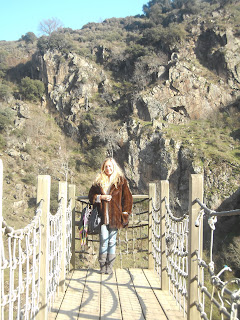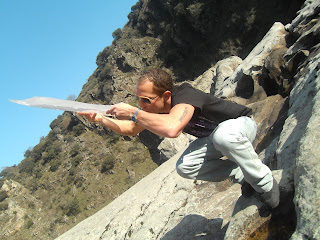On Saturday 18th February, it was one of my good friends birthdays and it was also the Carnival del Torros en Ciudad Rodrigo. Even better than both of those things however, was that as a surprise for Rob’s birthday, our old (and amazing) friend Tom (who has been in Salamanca forever, but sadly just left) made a surprise visit over from Ireland. Although Holly and I knew about this big secret birthday present and we went to collect him from the coach station on Thursday night, everyone else was so surprised, especially Rob! It was a really lovely weekend, having him back with us.
The Carnaval del Toro (of bulls) is the most popular festival in the town of Ciudad Rodrigo (Salamanca Province, Castile and Leon, Spain) which is held every year in conjunction with Carnival time in Spain.
It is a tradition at Ciudad Rodrigo for everyone to wear ‘un disfraz’ (fancy dress), so around 20 of my friends from my ‘residencia’ and I all set off early in the morning through the streets of Salamanca in our outfits. As it was Rob’s birthday, one of my good friend’s from Germany, Pippa, had made him a cake and we gave it to him on the way along with some sangria for the coach journey!
On the coach, we were all required to sign a contract agreeing that if we were injured during the running of the bulls or through any participation at the fiesta, that we were all responsible for our own actions and that the company we were going with would not be liable in any way for our safety… so practically signing our lives away!
The coach journey was so much fun as there was such a large group of us. When we arrived, we all stopped at ‘El Arbol’ ('The tree') supermarket to pick up some food and then chose a sunny spot on some grass to all have lunch together.
After this, we walked past a big fun fair, a market and some lovely old buildings towards the makeshift bull ring in the center of the chaos! In the bull ring, there were lots of people and we even made a few new friends!
By this time, it was drawing closer and closer to the running of the bulls. All the boys were busily preparing their dutch courage and even my loca amiga Holly decided to run with them! I meanwhile sat on the high wall that was to separate the bulls and the runners from the thousands of other people at the event.
After this we went to the large tent that was set up with a bar and a buffet, where by coincidence we met up with some of our American friends from Salamanca. Inside the tent, two of our visiting friends from Japan found a group of Spaniards dressed up as the Japanese military! Qué coincidencia!
Later we all went and sat on the beautiful city wall to enjoy the sun and prepare for the second running of the bulls.
During this time, I was proposed to by a thriller clad Michael Jackson, I was sat in an ancient (and fortunately not working) catapult and my friends climbed up part of the city wall!
Later we all decided to go to the funfair while there was still some daylight, some of us were a little worse for wear than others, but it was still so much fun!
Later, was the second running of the bulls, which was far more frantic, as it was getting dark by this time. We all again made new friends and dodged bulls in this wild outlandish experience!
I didn’t go to the actual bullfight, which took place in the middle of the day; neither did most of my female friends, as it is very brutal and graphic scene. Sadly, during the run, one of the bulls charged into another, who went on to have a heart attack and not even make it to the bullfight. Although I imagine that this ruthless blood sport will be banned in the future, it is still a very astute insight into Spanish culture and customs, and all in all, apart from pity for the bulls, it was an amazing and intense day for most!

























































































































